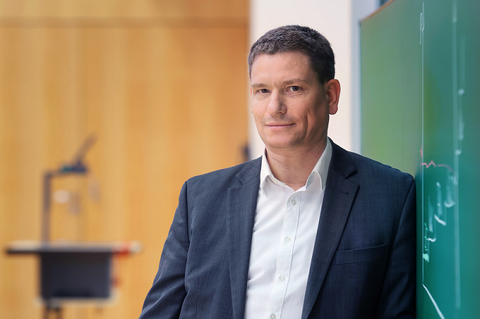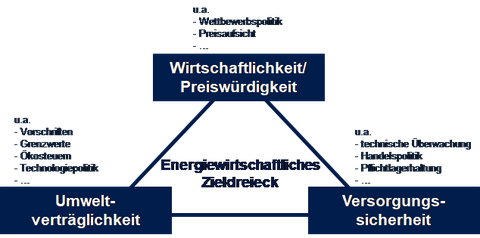Sep 07, 2022
Climate protection goals and energy security as conflicting priorities
Essay by Prof. Dominik Möst, Chair of Business Administration, esp. Energy Economics
The war in Ukraine has put our dependency on Russian natural gas in the media spotlight. The conflicting interests of the energy policy objectives triangle of environmental protection, secure energy supplies, and competitiveness are thus suddenly intensified (see Fig. 1). While in recent decades the focus was on environmental compatibility, the current crisis has brought secure supplies, but also the competitiveness or value for money of energy, into sharper focus. In his essay, Professor Möst highlights the challenges arising from the conflicting priorities of the objectives triangle and their significance for the energy transition.
As a result of the current crisis, energy efficiency and renewable energies will be boosted, both in Germany and worldwide
The war in Ukraine and the high prices of fossil fuels highlight the importance of renewable energies and energy efficiency. Investments in renewable energies and energy efficiency have become even more attractive due to high fossil fuel prices. The long-term goal of Germany's energy policy to push renewable energies and energy efficiency forward is therefore reinforced by the current situation. Each new wind turbine or solar power system ousts fossil fuel energy supply (and thus saves CO2 emissions and energy expenditures), at least as long as it does not exceed demand. Moreover, the high prices encourage investment in the more economical use of energy, i.e. energy efficiency.
The coalition agreement of the German government calls for the expansion of renewable energies with extremely ambitious targets. It envisages an approximate three to fourfold increase over the next 10 years compared with the average expansion over the last decade. This necessary speed-up alone illustrates the immense challenge of the expansion. The fact that the expansion has been slow in recent years due to various obstacles is now aggravating the energy transition – as are foreseeable higher material prices – and makes the targets appear unrealistic. Had faster expansion been easy so far, the use of renewable energy would already be much further along. This raises questions as to whether and how such an acceleration of expansion can succeed, but also how renewable energies can be integrated into the system in the face of increasing surplus feed-in.
Wind power and photovoltaics are no substitute for secure power generation
The expansion of weather-dependent renewable energies raises the issue of secure supplies. While energy generation from wind and photovoltaics ousts fossil fuels, its characteristics are not the same as those of coal, natural gas, and nuclear power generation. What is needed is a secure supply of power that is always available. The stack of coal in front of the power plant is the allegoric energy storage that is missing with weather-dependent renewable energies. In recent years, the energy objectives triangle has been dominated by the focus on environmental protection and the corresponding operationalization. Supply security was always taken for granted and was never a problem. Energy policy discussions were characterized by phase-outs and phase-out dates. In all scenarios for the future, natural gas power plants were previously envisaged as a “bridge” for secure power, which was to be replaced by the vision of “green” hydrogen. The potential loss of Russian natural gas supplies has suddenly revealed our dependency on natural gas as an energy source and as an essential element to ensure our electricity security. The strong volatility in feed-in from renewable energies and the issue of the lacking guaranteed power supply have been a major point of criticism with regard to the energy transition for years. Phasing out nuclear energy and coal has so far meant relying on natural gas as a bridge energy source in the power grid. Even with an extremely rapid expansion of renewable energies, especially wind power and photovoltaics, the gap cannot be closed without conventional energy sources. The current situation reveals the true core of this criticism and results in the pragmatic decisions to reuse coal-fired power plants that had already been shut down, which will lead to a significant increase in CO2 emissions in Germany. Moreover, and depending on the outcome of the current stress test, the continued use of the last nuclear power plants still connected to the grid even beyond the envisaged phasing out in 2022 is also being discussed. Phasing out technologies without real alternatives is therefore not a sustainable solution. The point is not to phase out coal-fired power plants as fast as possible, since CO2 only occurs as a joint product if there is any production. Instead, we need to reduce the power generation from coal-fired and natural gas-fired power plants. Therefore, the key question is not how to phase out coal capacity more quickly, but how to expand renewables more rapidly and how to provide a guaranteed supply in the medium to long term.
In addition to the need to guarantee power supply, the continued expansion of renewable energies will pose the equally pressing challenge of integrating a considerable amount of surplus power, which will require not only technically feasible but also economically advantageous solutions.
Decarbonization in heating and mobility poses immense challenges
Although the demand for heating far exceeds electricity consumption, the transformation of the heating sector is a topic that rarely receives public attention. A large proportion of energy consumed in private households is for heating the rooms and the water. The supply of heat has received a lot of attention due to the war in Ukraine because almost 50% of German households heat with natural gas. The price of natural gas on the wholesale market was between 15 and 30 EUR/Mwh for the last 20 years, but rose to over 100 EUR/Mwh before the war broke out. Unlike with crude oil, where a decline in prices was already foreseeable in the prices of the futures market over the last few years, the prices of the futures market for natural gas is set to sykrocket over the next few years. The natural gas from Russia, which has been cheaply supplied via pipelines so far, is to be permanently substituted by other supply sources. Therefore, the challenge in the coming months and years is to ensure a reliable and affordable heating supply for the industry and the population. This gives the current conflict a strong social component, especially because the expenditure for natural gas will increase significantly in comparison to past heating periods. For individual households, it is foreseeable that it will double or even triple compared to before the conflict. As natural gas power plants frequently determine prices on the electricity market, it is not only gas prices that are affected, but also electricity prices. This means that the aspect of being “value for money” – as a low-cost energy supply – of the energy policy objectives triangle will also be in the foreground in the coming years.
Similarly, today’s mobility is largely based on fossil fuel. More than 90% of the energy in the transport sector is based on petroleum products. The German government has already decided on relief measures for petrol and diesel, even though the prices for crude oil and its derivatives have “only” risen moderately compared to natural gas. Crude oil and natural gas are still by far the most important energy sources globally, but also in Germany: both together have a share of about 60% in the primary energy balance. This shows the gravity of the political desire to provide climate-neutral energy , without the use of raw fossil fuels.
Investments in fossil fuel energy production are also attractive and global CO2 emissions will continue to rise
The high prices for fossil fuel energy sources are encouraging investments in renewable energies all over the world, but also investments in fossil energies. The high oil prices are not a direct result of the war in Ukraine, but the war is exacerbating the price increases. Prior to the Covid-19 pandemic, oil production had reached over 100 million barrels a day. During the pandemic in 2020, this demand shrank by about 8 percent. With the oil demand picking up significantly in 2021 and 2022, production capacity is expected to expand to between 103 and 108 million barrels per day over the next decade (despite global efforts to address climate change), and high oil prices are spurring on investments in production. However, in order to reduce CO2 emissions worldwide, the fossil fuels crude oil, natural gas and coal must remain unearthed. This is because every fossil fuel that is extracted is burned and therefore contributes to further CO2 emissions. This effect is even more drastic at the moment because the use of coal as a substitute for natural gas in the production of electricity or crude oil in the production of heat is once again significantly more attractive due to the high prices of natural gas, which leads to higher CO2 emissions due to the change in fuel. It is not realistic to expect that countries exporting crude oil, natural gas and coal refrain from selling their raw materials and that these raw materials will not be used. Even the current example of Russian raw materials shows that there is a high demand via other channels, sometimes with price discounts. Against this background, annual global CO2 emissions are expected to continue to rise for the foreseeable future. This challenge is and will remain unsolved as long as major emitters are able to evade a climate protection agreement, energy demand continues to rise globally, and the increase is largely powered by fossil fuels. It remains to be seen to what extent the idea of a sufficiently strong Climate Club of participating countries, as proposed by Nobel laureate Nordhaus, can prevail in the current geopolitical situation. In addition to an adequately large Climate Club with binding commitments, the decisive factors will be what alternatives exist to the use of fossil fuels and how quickly an expansion of renewable energies can succeed on a global scale (or how fast carbon capture and storage technologies can become established). We are facing the dilemma that an extremely rapid shift away from fossil fuels, which would be necessary for climate protection, cannot be reconciled with current energy demands and prosperity structures.
The challenge lies in the pace of the global energy supply transformation
In summary, the simple truth is: (More) sustainable climate-neutral power generation will essentially be based on renewable energies and more efficient energy use. More renewable energy will oust conventional energy sources and every kilowatt hour that is saved does not have to be generated. Yet, what is also true is that the speed of transformation required to achieve climate goals is an immense challenge. This applies both to the German and especially to the global energy supply.


